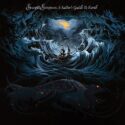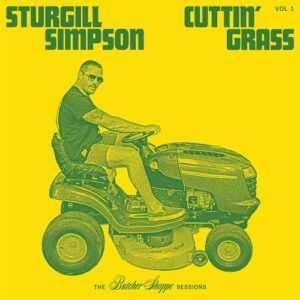Sturgill Simpson
| Track | Album |
|---|---|
| Water In A Well | High Top Mountain |
| Old King Coal | High Top Mountain |
| Turtles All The Way Down | Metamodern Sounds In Country Music |
| The Promise | Metamodern Sounds In Country Music |
| Long White Line | Metamodern Sounds In Country Music |
| Breakers Roar | A Sailor's Guide To Earth |
| All Around You | A Sailor's Guide To Earth |
| I Wonder | Cuttin' Grass Vol.1 |
| I Don't Mind | Cuttin' Grass Vol.1 |
| Hobo Cartoon | Cuttin' Grass Vol.2 |

Contributor: Andrew Shields
Although his first solo album was released as recently as 2014, since then John Sturgill Simpson has gone on to have one of the most interesting and varied careers in contemporary music. In the early part of his career – along with a small group of like-minded artists including Chris Stapleton, Jamey Johnson and JP Harris – he was seen primarily as something of a revivalist artist (that is if ‘revivalist’ is taken to include a willingness to extend the tradition rather than slavishly imitate its past masters). This group of artists was among the few recent ones whose music had something of the same kind of directness, emotional honesty and candour which characterised the work of previous great songwriters in the genre such as Hank Williams or Merle Haggard. However, while all of them shared a deep respect for the pioneers of country music in the 1950s and early 1960s, in their own work they displayed a willingness to incorporate influences from outside the genre which gave it a freshness and verve that many of their contemporaries lacked. In Simpson’s case, these outside influences included those derived from his early fondness for ‘southern’ rock bands and for soul artists like Marvin Gaye and Bill Withers. Within the country fold, his key influences came from ‘outlaw’ country artists like Willie Nelson and from their Bakersfield contemporaries, in particular Merle Haggard.
After his first album, Simpson’s music became increasingly diverse in style, and he began to experiment with a wide variety of genres These include forays into psychedelia, soul, funk and – with the album Sound & Fury (2019) – a perhaps misguided stab at hard rock. He also had several very public clashes with the country music ‘establishment’ which reinforced his reputation as an outlaw against it. This also indicated a kind of turbulent restlessness which was at the heart of both his musical experimentation and of the unpredictable character of much of his best work.
What also singled Simpson out is his voice, which is one of the finest in modern country music. It combines subtlety with grit in a manner reminiscent of past greats such as Waylon Jennings. Indeed, Waylon’s son, Shooter Jennings, has stated that Sturgill’s vocal style reminds him of “my favourite era of my dad, the Seventies, when he would sing quieter and more conversational”.
My first choice, Water In A Well, is a superb example of this facet of Sturgill’s singing. It comes from his 2013 debut album, High Top Mountain, which is the most ‘country’ of his albums to date. It also features an exceptional cast of musicians including the great Hargus ‘Pig’ Robbins on piano. Robbins had previously played on albums by artists of the stature of George Jones, Merle Haggard, Bob Dylan, Dolly Parton. The CD was brilliantly produced by Dave Cobb who is also well known for his work with other rising stars at the time like Jason Isbell and Chris Stapleton. ‘Water’ is a classic slow ballad on which Simpson shows his complete mastery of the art of country singing.
My other choice from the album, Old King Coal, is an elegiac song about Simpson’s hometown of Jackson, Kentucky. It was an old mining town and most of his family on his mother’s side had worked in the pits there. The song deals with the devastating impact which the slow demise of that industry has had on the town. It also explores the social problems which stemmed from the sense of decay and hopelessness which accompanied that decline. Here is a live performance.
If Sturgill’s first album had been the work of an extremely talented, if not yet fully developed artist, his second CD, Metamodern Sounds In Country Music, signalled his emergence as a songwriter with an individual style and distinctive poetic sensibility. On it, he achieved a remarkable new musical synthesis based on a fusion of his disparate influences; the styles on the record ranged between country, rock and psychedelia. There was at times even a slight hint of electronica. The lyrics on the album also displayed Simpson’s interest in cosmological questions. The most notable example of his taste for such issues is Turtles All The Way Down. This must be one of the few country songs which, in Thom Jurek’s words, references sources and individuals as disparate as “Jesus, the Old Testament, Buddha, mythology, cosmology, drugs, and physics”. More broadly speaking, the song manages to encompass reflections on Simpson’s general search for the meaning of life, on his hallucinatory experiences while on drugs and on his relationship with his wife. A more thorough exploration of the influences which led Simpson to write the song can be found here. The official video for the song was made with help from – in Simpson’s words – “the visionary software artist” Scott Draves.
My second choice from the album, The Promise, is a cover of a song by the 80s English band, When in Rome. In their hands, the song was a catchy piece of synth-pop. However, Sturgill’s version takes it to an entirely different level of soulfulness and artistic excellence. It’s also, arguably, his greatest vocal performance to date.
Both the arrangement and production also display a clear debt – in my opinion – to Elvis’ great late 1960s comeback albums, From Elvis In Memphis and Back In Memphis.
My final choice from the CD, Long White Line is a far more recognisably ‘country’ song than my other choices from Metamodern Sounds. It also displays his masterly phrasing. Here’s a fine live version with some great guitar playing from the Estonian-born Laur Joamets who was a mainstay of Simpson’s band in the early days.
Sturgill Simpson’s next release, A Sailor’s Guide To Earth, was an ambitious concept album which centred around the birth of his son. While undoubtedly uneven (it includes a version of Nirvana’s In Bloom which – while interesting – adds little to the original), the best songs on it rank among some of the finest of his career. My first pick from it, Breakers Roar, is a beautiful but bittersweet reflection on some of the harsh lessons that life will bring for his child.
Simpson also sings Breakers Roar with a gentle quality which is quite different from some of his other performances. By contrast, All Around You brings to the surface the soul influences which had underlain his music from the beginning
My final selections come from the two excellent ‘bluegrass’ albums he made last year, Cuttin’ Grass Vols.1&2. These were recorded with a brilliant group of musicians including Sierra Hull on mandolin, Scott Vestal on banjo and Tim O’Brien on rhythm and lead guitar. The two albums are mainly made up of reinterpretations of songs Simpson had previously recorded in a bluegrass style. Unlike many similar records, they both work really well. This is partly due to the sheer quality of the musicians involved in making them. However, the relaxed feel at these sessions also led to Simpson singing with an ease and freedom which is unique in his work up until this point. Among my choices here, I Wonder and I Don’t Mind (which Simpson first recorded with his original band, Sunday Valley) are truly outstanding examples of ‘pure’ country singing. I Don’t Mind is also one of his most directly personal lyrics. Hobo Cartoon is a more recent song, written with one of Simpson’s heroes, Merle Haggard. In a way, it is fitting that the song itself marks a passing on of the torch from one great and occasionally turbulent country singer-songwriter to another.
To conclude, I should add that Sturgill’s voice is just as impressive live as it is on record. I had the good fortune to see him play a very intimate gig – with a surprisingly small audience – in Dublin in early 2016. The gig as a whole was excellent but the highlight for me was when he did a brilliant version of the great Lefty Frizzell’s song, I Never Go Around Mirrors. Before singing it, he advised anyone who did not like country to leave because “for many people, it is the quintessential country song”. Sturgill’s version that night was superb and he did that great song full justice. Here he is performing it on KEXP in 2013.
It may very well be that, however good Sturgill Simpson’s work has been to date, his best material may be yet to come. He is both outrageously talented and massively unpredictable so there may be many surprises in his future career. He has already built up one of the most impressive back catalogues in modern country music.
Sturgill Simpson official website
Uproxx interview 2020
Sturgill Simpson Has A Lot To Get Off His Chest
Guardian interview 2015
People think I pour LSD on my Cheerios
NPR interview 2014
‘I Wanna Make Art’: His Twisting Path To Nashville
Fader interview 2014
Nashville bigwigs, undercover cops, lizard aliens …
Saving Country Music interview 2015
Don’t Compare Sturgill Simpson to Waylon . . . Unless You’re Merle Haggard. That’s probably okay.
VMP Record of the Month – April 2021
Listening Notes for ‘Metamodern Sounds in Country Music’
Sturgill Simpson biography (AllMusic)
Andrew Shields is a freelance historian, who grew up in the West of Ireland and currently lives in Sydney, Australia. Along with an interest in history, politics and literature, his other principal occupations are listening to and reading about the music of Bob Dylan and, in more recent years, immersing himself in the often brilliant and unduly neglected music of Phil Ochs.
Read the Toppermosts on these great American country singers mentioned in this post: Lefty Frizzell, Merle Haggard, Jason Isbell, Waylon Jennings, Jamey Johnson, George Jones, Dolly Parton, Hank Williams
TopperPost #971









Thanks for this TOPPERMOST. It made me pick up my ol’ mountain-style banjo from the 30s and “play with” Sturgill.
On the other hand . . . I am interested in connection with popular music with history and politics. What I see now is the well-known symbol with an eye and a pyramid. I didn’t find any clue in your text (maybe I did not read carefully?). Could you please explain this or post a link, maybe.
Thanks for comment Ilkka. It was our esteemed editor who found photo of poster. Can’t say I know very much about the symbol but I did find this. Do know that Sturgill is into various types of esoteric knowledge but no hidden messages were intended to be planted here – unless this was done by the editor or the illuminati without my knowledge!
When people tell me that country music is dead, I’d often point to Sturgill. And now I have a concise list with a great article to send them too. Thanks Andrew.
Thanks for this David. A few contenders for ‘saviours’ of country music at the moment but I do think Sturgill has one of the most legitimate claims.